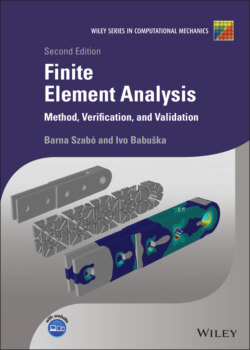Читать книгу Finite Element Analysis - Barna Szabó - Страница 49
1.6.2 The exact solution lies in ,
ОглавлениеIn this section we consider a special case of the problem stated in eq. (1.103):
(1.120)
with the data , and defined such that the exact solution is
(1.121)
that is,
(1.122)
On integrating by parts, we get the following expression which is better suited for numerical evaluation:
(1.123)
We address the following questions: (a) How does the error in energy norm depend on the parameter α, the mesh Δ and the p‐distribution p? and (b) How is this error distributed among the elements? Understanding these relationships is necessary for making sound choices of discretization based on a priori information concerning the regularity of the exact solution.
We compute the potential energy of the difference between the exact solution and its linear interpolant for the kth element:
The exact solution for and its linear interpolant for , uniform mesh, are shown in Fig. 1.12.
To obtain the potential energy of the difference between the exact solution and its linear interpolant for the kth element, denoted by , we need to solve:
(1.124)
Figure 1.12 The exact solution for and its linear interpolant for , uniform mesh.
The solution is
(1.125)
Using eq. (1.106) we get
(1.126)
where is the difference between and its linear interpolant:
(1.127)
and compute
Referring to Theorem 1.5, the error in energy norm associated with the kth element is
(1.128)
and the relative error in energy norm associated with the kth element is:
(1.129)
The error of approximation over the entire domain is:
(1.130)
By Theorem 1.2, the exact value of the potential energy is
(1.131)
and the relative error in energy norm on the entire domain is:
(1.132)
Remark 1.13 In estimating the local error we used . It can be shown that in the special case of this problem () this relationship holds and therefore using the equal sign in eq. (1.128) is justified. In the general case () however, and eq. (1.128) will be an estimate of the local error in the finite element solution. Therefore the equal sign in eq. (1.128) has to be replaced by the approximately equal () sign and the first equal sign in eq. (1.130) has to be replaced with the less or equal () sign.
Example 1.13 This example illustrates the distribution of the relative error among the elements for a fixed mesh and polynomial degree for selected fractional values of α. Uniform mesh on the domain with and for is used. The exact solution for is shown in Fig. 1.12. The percent relative error in energy norm associated with the kth element, given by eq. (1.129), is shown in Table 1.4 and the relative error for the entire domain is shown in the last column.
It is seen that for all values of α the maximum error is associated with the first element.
Example 1.14 This example illustrates the distribution of the relative error among the elements for a fixed mesh and polynomial degree for selected integer values of α. Uniform mesh on the domain with and for is used. The percent relative error in energy norm associated with the kth element, given by eq. (1.129), is shown in Table 1.5 and the relative error for the entire domain is shown in the last column.
The error of approximation for is zero. This follows directly from Theorem 1.4: The exact solution is a polynomial of degree 2. Therefore it lies in the finite element space and hence the finite element solution is the same as the exact solution.
Remark 1.14 In the foregoing discussion it was tacitly assumed that all data computed by numerical integration were accurate and the coefficient matrices of the linear equations were such that small changes in the right‐hand‐side vector produce small changes in the solution vector. This happens when the condition number of the coefficient matrix is reasonably small. In the finite element method the condition number depends on the choice of the shape functions, the mapping functions and the mesh. In one‐dimensional setting the mapping is linear and the shape functions are energy‐orthogonal, therefore round‐off errors are not significant. This is not the case in two and three dimensions, however.
Table 1.4 Example: Element‐by‐element and total relative errors in energy norm (percent) for selected fractional values of α.
| Element number | ||||||
|---|---|---|---|---|---|---|
| α | 1 | 2 | 3 | 4 | 5 | |
| 1.25 | 79.49 | 7.50 | 2.80 | 1.63 | 1.12 | 4.80 |
| 1.15 | 99.52 | 4.06 | 1.63 | 0.97 | 0.67 | 3.92 |
| 1.05 | 29.56 | 1.24 | 0.53 | 0.32 | 0.22 | 1.77 |
| 0.95 | 18.89 | 1.16 | 0.52 | 0.32 | 0.22 | 2.41 |
| 0.85 | 42.94 | 3.26 | 1.52 | 0.94 | 0.67 | 9.84 |
| 0.75 | 60.39 | 5.14 | 2.47 | 1.56 | 1.11 | 22.37 |
| 0.65 | 76.07 | 6.86 | 3.39 | 2.16 | 1.56 | 42.91 |
| 0.55 | 91.80 | 8.44 | 4.28 | 2.76 | 2.00 | 76.22 |
Table 1.5 Example: Element‐by‐element and total relative errors in energy norm (percent) for selected integer values of α.
| Element number | ||||||
|---|---|---|---|---|---|---|
| α | 1 | 2 | 3 | 4 | 5 | |
| 1 | 0 | 0 | 0 | 0 | 0 | 0 |
| 2 | 11.00 | 61.24 | 15.31 | 7.02 | 4.55 | 2.45 |
| 3 | 20.09 | 4.69 | 98.83 | 16.16 | 9.24 | 4.62 |
| 4 | 36.98 | 8.41 | 17.24 | 30.13 | 14.02 | 8.00 |
Errors in numerical integration can be particularly damaging. The reader should be mindful of this when applying the concepts and procedures discussed in this chapter to higher dimensions.
